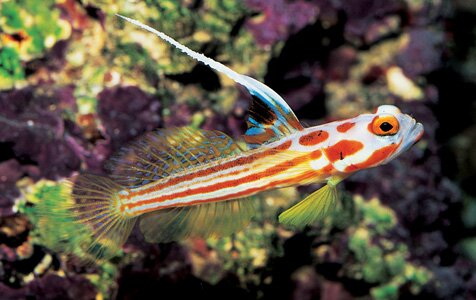User's Guide to Species Profiles - Fishes
From Microcosm Aquarium Explorer

Whiteray Shrimp Goby, Stonogobiops yasha.Scott Michael
Meant as a field guide to aquarium species, the Microcosm Aquarium Explorer™ Species Profiles use color photographs taken in the wild as well as in aquariums for quick visual identification.
In addition to a species overview and notes about aquarium behaviors and compatibility, each account contains concise facts and advice, organized as follows:
Common Name
One or more common names are listed for each species. The first name provided is the name most frequently used in the authoritative checklists and field guides written by ichthyologists and marine biologists.
Scientific Name
This is the most-current name applied to the fish by the scientific community. The name is in the form of a binomial. The first name indicates the genus to which the fish belongs, while the second is the species name. When common names are confusing, the scientific name is a benchmark that all can understand.
For example, Amphiprion ocellaris is the scientific name for a much-liked reef fish that goes by all of these common names: Ocellaris Clownfish, Common Clownfish, False Percula Clownfish, False Clownfish, Clown Anemonefish, and others. We choose to use Ocellaris Clownfish, which has both clarity and growing popularity.
The genus name often provides a clue to the traits and keeping requirements of other closely related species grouped within that genus.
Native Range
This entry notes the geographical area where each species occurs in nature. The distribution of a fish, invertebrate, or plant is of great value to aquarists wishing to set up a tank that represents a natural community or biotope from a certain geographical region.
Habitat
Many marine fishes will do best in aquariums aquascaped to replicate the portion of the reef they inhabit in the wild. Some need deep sand substrates to thrive, many others only acclimate well when provided a profusion of rocky caves, overhangs, bolt holes and hiding places in the reefscape to provide them a sense of security. Having the proper habitat is a major stress reliever for most coral reef fishes.
Maximum Length
For fishes, this indicates the greatest length that an individual of that particular species can attain—or the longest ever reported—measuring from the end of the snout to the tip of the tail. In most cases, the length of an aquarium specimen will fall short of this measure, but the aquarist should always plan for the prospect of his or her fish reaching a maximum length close to that presented.
Maximum Height
For plants, this indicates the greatest length that an individual of that particular species usually attains or is likely to attain in the well-kept aquarium.
Minimum Aquarium Size
This is the minimum suitable aquarium volume for an adult individual of the species. Of course, juveniles and adolescents can be housed in smaller tanks. Activity levels and behavior patterns of a particular species have been accounted for whenever possible. Please note that bigger aquariums are almost always better for most species. (The exception being very tiny fish and invertebrates that tend to be lost in large tanks.) The suggested sizes given throughout this book must be regarded as the minimum. Providing more space will allow any fish to acclimate better and display less aggression toward its tankmates.
Lighting
Recommended lighting levels for corals, photosynthetic invertebrates (such as Tridacna clams), and for aquatic plants are given. "Intense lighting" usually calls for high output fluorescent (VHO), power compact, or metal halide bulbs.
Feeding
Aquarium fishes vary dramatically in their feeding preferences and requirements. Advice in this section includes the type of foods generally preferred by the species. Daily or twice-daily feeding frequency is recommended for most aquarium species.
For more detailed anatomical descriptions of fishes, we suggest Fishbase.
—Scott W. Michael
101 Best Saltwater Fishes
101 Best Tropical Fishes








